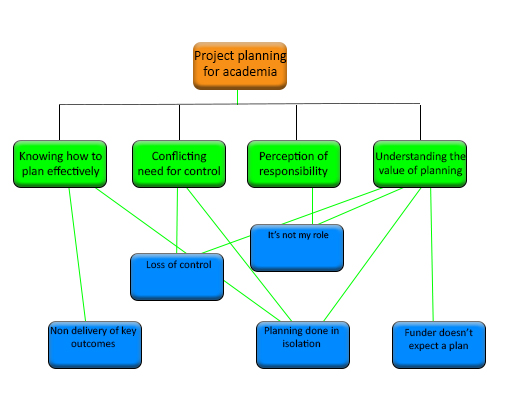1.1 Tricky topic of project planning
In this project planning tricky topic example, there are four stumbling blocks with at least one problem example underneath each. You may not understand the topic yourself but you should be able to see the four stumbling blocks.
The stumbling blocks and problem examples are shown below:
- SB1: understanding the value of project planning
- problem example: funder doesn’t expect a plan
- SB2: knowing how to plan effectively
- problem example: planning done in isolation
- problem example: non-delivery of key items
- SB3: conflicting need for control
- problem example: loss of control
- SB4: perception of responsibility
- problem example: it’s not my role
In effect, the problem examples are the symptoms, and the stumbling blocks represent the cause. Addressing the cause, i.e. helping the student overcome the stumbling block will alleviate the symptoms, i.e. eliminate the problem example. So, for problem example ‘non delivery of key items’ addressing SB2 ‘knowing how to plan effectively’, will help eliminate non-delivery of key items.
This tricky topic can then be structured using the structures in Week 2, in the form shown in Figure 3:
Activity 1 Structuring tricky topics
Sketch the structure of the stumbling blocks and problem examples into the tricky topic structure. This is the beginning of the structures that were used in Week 2 [Tip: hold Ctrl and click a link to open it in a new tab. (Hide tip)] . In the next part of this activity you will be using the IRIS Connect platform.
IRIS Connect is an online platform created to empower teachers to reflect on, analyse and collaborate through video technology. The platform allows you to develop your understanding of the tricky topic process through example videos from workshops and provides a space in which you can share, discuss and collaborate with other teachers and learners. It uses secure, cloud-based storage for you to share your on-going tricky topic process.
- Go to the IRIS Connect website.
- a.If you do not have an account with IRIS Connect, you can create a free account here.
- b.If you already have an account with IRIS Connect, you can log-in and go straight to the ‘Teaching and learning tricky topics’ Group or go to the groups tab > followed by the group store to find the ‘Teaching and learning tricky topics’ group.
- Once you’ve created your account and you are on the homepage, go to the groups tab > followed by the group store to find the ‘Teaching and Learning tricky topics’ group.
On the ‘Teaching and Learning Tricky Topics’ Group on IRIS Connect (see Week 3, Activity 1) you will see the video and mind map from Week 2, Activity 3. Reviewing this example may help you to formulate your ideas and see how the process is conducted in practice.
Share your reflections of the video with other teachers using the discussion box on IRIS Connect. Towards the end of the course you will see how you begin to consider sharing your own reflections using this platform.


